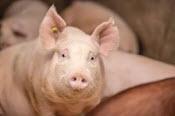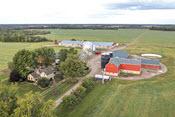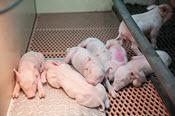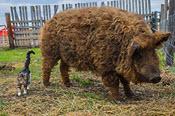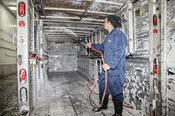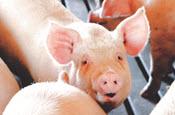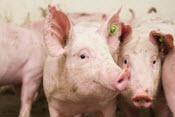Better Pork is published bimonthly. After each edition is published, we share two feature articles online. Each magazine includes much more content. If you enjoy reading the Better Pork articles below, be sure to subscribe to the magazine!
Lowering our carbon footprint
By Drew Woods, M.Sc, NutriOpt Models Manager, Trouw Nutrition
New terms have entered the lexicon of pork production in the past decade, and the newest and arguably most important one is sustainability.
Canada working feverishly to keep it out
By Geoff Geddes
While the pork sector has clearly had its fill of African swine fever (ASF), the feeling is far from mutual. As a double-barreled threat that is both deadly and contagious for pigs (yet no threat to humans or food safety), ASF now affects all areas of China, as well as sub-Saharan Africa, Mongolia, Vietnam, and parts of the European Union.
When issues arise, science steps up.
By Geoff Geddes
Just as a shark must keep moving to survive, the pork sector must evolve to stay afloat. In a business where the waters are often choppy, cutting-edge research plays a huge role. Whether it’s feed efficiency, genetics or animal welfare, producers and scientists are always seeking improvement in traditional areas of production while keeping one eye on emerging issues and the “next big thing.”
A flood of advice for coping with a crisis
By Geoff Geddes
“Out of sight, out of mind” can be a sound philosophy, until it isn’t. Pork producers may do everything else right, but if they’re unprepared when a crisis hits, it can all go wrong in a heartbeat. That fact is not lost on pork organizations across the country, and is prompting a renewed call for emergency planning and everything that it entails.
As the world moves away from pharmacological zinc oxide, do we have other options?
By Brenda Christensen, Dr. Elijah Kiarie & Dr. Lee-Anne Huber
Weaning is a difficult transition for piglets.
Removal from the sow, mixing with other pigs, changes in diet composition and form, and fading maternal immunity all contribute to reduced feed intake and increased susceptibility to enteric disease. Typically, low feed intake immediately after weaning is the main driver of the post-weaning growth lag.
Breeders continue to keep the traditions alive
By Colleen Halpenny
In today’s fast paced innovative world, sometimes the slower paced ways can be brushed to the side. However, a growing number of pork producers are making the effort to work with heritage breeds and deliver those old-time flavours to the table.
Better Pork spoke with three business owners to learn what drove them to these unique breeds, how they stand up in Canada’s changing climate, and what they offer to consumers.
Canadian farmers continue to work at finding the balance in the budget.
By Colleen Halpenny
Whether you call it moonlighting, a side gig, or bonafide employment, many pork producers are known for more than their farm and take on extra work to pay the bills.
With everyone regardless of lifestyle or job sector feeling the pinch of increasing living costs, how are producers making ends meet?
We spoke with those in the industry to find out why, and how, they’re turning to outside income to support their needs.
Vehicles play a significant role in the virus’s spread.
By Becky Dumais
“Porcine reproductive and respiratory syndrome virus (PRRSV) remains one of the most economically significant viruses in North American pig production and global pig production. PRRS is a beast,” says Egan Brockhoff, veterinary counselor with the Canadian Pork Council.
Managing harmful behaviour that can occur in swine production.
by Colleen Halpenny
While aggression is a natural trait in any animal, in swine it can be extremely detrimental, with after-effects like physical damage or changes in an attacked animal’s behaviour.
Exploring Canadian research findings & benchmark goals.
by Kristen Lutz
“As a population that’s interested in animal health, we’ve been trying to solve the porcine reproductive and respiratory syndrome virus (PRRS) for decades. We’ve had some successes but it’s complicated,” says Zvonimir Poljak, DVM, associate professor with the Ontario Veterinary College.
PRRS has swept through North America since the late 1980s and scientists continue to investigate it, particularly the genetics of the disease.




